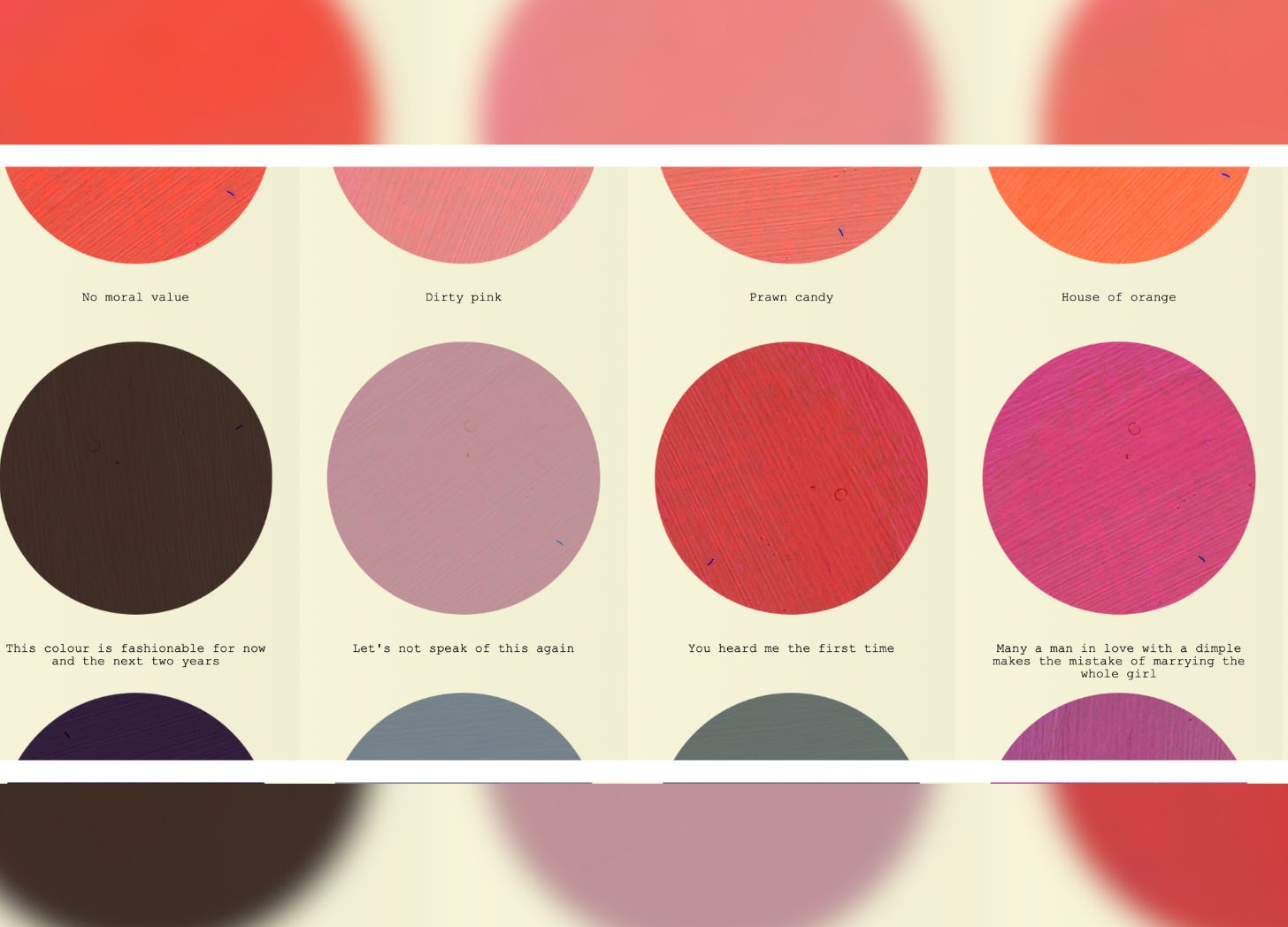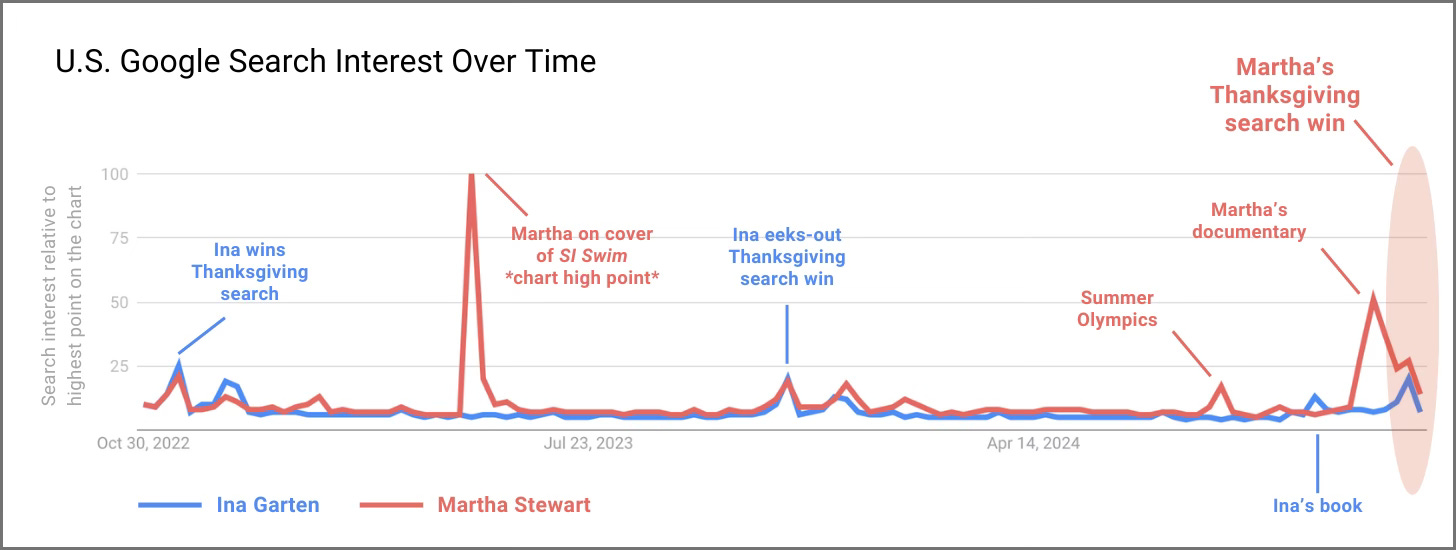Magnificent Colour. Squirm Words. Girl Water (Yawn, Nestlé).
And who's winning the Ina vs. Martha exposure battle?

From London (Mia)
I didn’t expect to see the words “anal gland” and “poop revolution” plastered all over my London neighbourhood, but here we are. And I’m kinda into it. Dog care brand Scooch isn’t sugar-coating or tiptoeing around language that some might find off-putting. They’re leaning all the way in. And let’s face it—every dog owner knows the infamous floor scoot and what it’s trying to fix. It’s just part of life with a pet. The more we normalise so-called ‘uncomfortable’ words, the less power they have to make us squirm… and the more they can start real conversations (which is why I also appreciate Smile Makers’ ‘It’s vulva, not vagina’ packaging).
In the middle of a Monday packed with file transfers, WeTransfer reminded me why it’s so brilliantly on brand. Its content platform, WePresent, showcases work by global creatives in place of ads, thereby cementing its status as a friend to, and active participant in, the creative community. Yesterday, while uploading a naming document for a crisp brand (I’m naming a lot of crunchy snacks right now), I got absorbed in an essay on solitude by Sheila Heti. Six minutes unexpectedly well spent.
“Colour is unavoidable. It’s fundamental. It’s everywhere. It's colour that sells.” So says Simon March, the founder of British paint company Colour Makes People Happy. I mentioned a couple of weeks ago how ‘cool kid’ disruptor Lick is giving legacy paint brands like Farrow & Ball a run for their money. But Lewes-based CMPH, which creates its paint from entirely natural local ingredients from the nearby South Downs, might be doing an even better job. The company’s manifesto is punchy and inspiring, and they create colours by hand at their in-store paint bar. But it’s the product names that get me. CMPH understands the nuanced emotions that go into painting one’s home and the inherent connection between colour, psychology and building a world that reflects who we are— or who we want to be. I’m considering painting my downstairs bathroom in “A colour to make me think a little bit about London” and doing some trimwork in “Put me down for $5 for that shirt in the window.”
Speaking of enjoyable product naming, Completed Works nails it with the playfully intriguing names for its jewellery—perfectly aligned with the compelling brand world it’s building. As someone who selects nail polish largely based on the name (thank you for your service, OPI), I welcome this fun, spirited approach. My favourite pieces are “Knee-Deep in a Bog in Yorkshire,” “Buttercream (or the Icing on the Cake)” and “The Inevitable Husband.”
From Chicago (Ellen)
Something tells me Unwell is not going to go well. Unwell is the upcoming Nestlé-Alex Cooper functional water launch that has been the talk of many business circles lately. Cooper, the popular podcaster and celebrity force behind the launch, claims the beverage is special because it’s targeted to women. Ummm… that sounds more like a marketing strategy vs. an innovation strategy, but ok. Also, what about Propel, the mother of all fem-targeted hydration? But these points aside, no one really cares about the gender specificity of their foods and beverages (unless we’re talking nutrition supplements). Remember, bro-gurt? That was a flop. Hopefully there’s more to Unwell than just being “for women, by women (but… shhh… not really because Nestlé actually makes the stuff).”
My holiday online shopping award goes to… no, not DudeRobe (but I thought about it)… M.M. LaFleur! My sis turned me on to this brand for its effortless biz-caszh styles, but I was more taken with its insightful language and better-than-in-store online shopping experience. To anyone in the DTC space, put M.M. LaFleur on your watch list. They’re doing some simple things that make all the difference in the world:
A “New to M.M.?” line tutorial and starter capsule (thank you very much!)
Straightforward body type recommendations (e.g., “hips-friendly” and “middle-friendly”) and model size comparisons for every single garment.
Zoomable or close-up fabric swatches that double as quality and care cues.
Transparency around customers’ feedback on fit.
Proof exposure = expertise (in this unscientific but fascinating analysis). One of my small delights of the past week was listening to Ina Garten’s interview with Michael Barbaro of The Daily. Michael started by saying, “Ina, you’re having a moment,” in reference to her resurgence in adoration and cultural conversation since the release of her memoir, Be Ready When The Luck Happens. You know who else is having a moment? Her contemporary, Martha.
Was this simultaneous revival planned by their respective PR gurus? Probably, and it’s revealed some interesting marketing science. Ina’s recent exposure has been mostly positive and consistent with her known expertise in cooking, hosting and homemaking. On the other hand, Martha’s exposure has been more negative— or at least heavily scrutinized— and pretty off-brand from a cooking/homemaking standpoint. She first re-emerged as the cover model for the May 2023 Sports Illustrated Swimsuit Issue, then opposite Snoop Dogg as a commentator for the 2024 Summer Olympics, and finally as the straight-talking subject of her Fall 2024 self-named Netflix documentary. Despite the relative negativity and randomness of Martha’s exposure, it’s been massive—arguably much larger than Ina’s re-rise.
And apparently, scale matters and translates to perceived expertise. In the ultimate test of who’s the “hostess with the most-est” (i.e., Thanksgiving week Google search interest), Marta took the lead this year, robbing Ina of her “Mrs. Thanksgiving” crown. I’m not necessarily advocating for random exposure as a sound growth strategy, but this ongoing battle for kitchen re-supremacy is telling. Any exposure is good (I guess). Martha’s upcoming cookbook is already a “No. 1 Bestseller,” and it hasn’t even been officially released yet.
In case you’re wondering, our topics and links are never sponsored.







